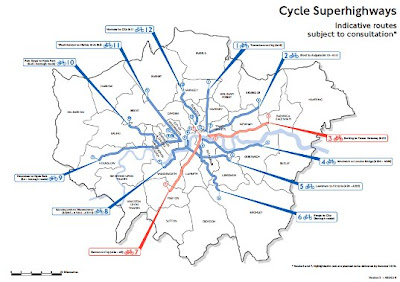In places like Amsterdam, the streets are filled with mainly bicyclists and pedestrians, and private vehicles are the minority. This is mainly due to the proximity of destinations to eachother, as well as the cultural attitude towards environmentally-friendly transportation, and also the state of the infrastructure and ease of travel.
So, in cities which appear to favour vehicular transport (public or private) by consuming most of the streets within the urban fabric, the promotion of using alternative modes of transport (bicycles, etc) is somewhat obstructed due to safety concerns and the unfamiliar idea of 'shared streets'.
We have started to see dedicated bicycle lanes in Brisbane - but London have taken this idea and put it on steriods.
As a way to encourage bike commuting and improve safety for bicyclists on the road, London is opening a series of bike superhighways along important commuter routes. The first two Barclays Cycle Superhighways just launched today to mark the beginning of what London Mayor, Boris Johnson, calls a “cycle revolution“. Painted a bold, bright blue, the cycle highways are 1.5 meters wide and they provide a safer space and more efficient routes for cyclists to travel.
London isn’t the only locale pumping up its bike infrastructure. Other cities, like New York and Los Angeles are working on setting up biking networks, widening traffic corridors, and adding more lanes. London’s new bicycle superhighway network has 12 planned routes in all, but the first two are ready as of today.

The new bright blue bike lanes are designed to provide efficient thoroughfares for bikers, and more importantly, provide them with a safe space in which to ride. With 13 cyclist fatalities in 2009 alone, the city of London acted to help ensure the safety of their bikers while fostering a growing community devoted to low-carbon travel. 
It may take some time before the cars get used to staying out of the blue lanes, but eventually the city will grow accustomed to them and learn to share the road better. The bike lanes are just one aspect of the London cycling revolution, which includes a city-wide bike hire scheme, a new cycling police unit, 66,000 extra bike parking spaces before 2012, and better strategic planning.





No comments:
Post a Comment